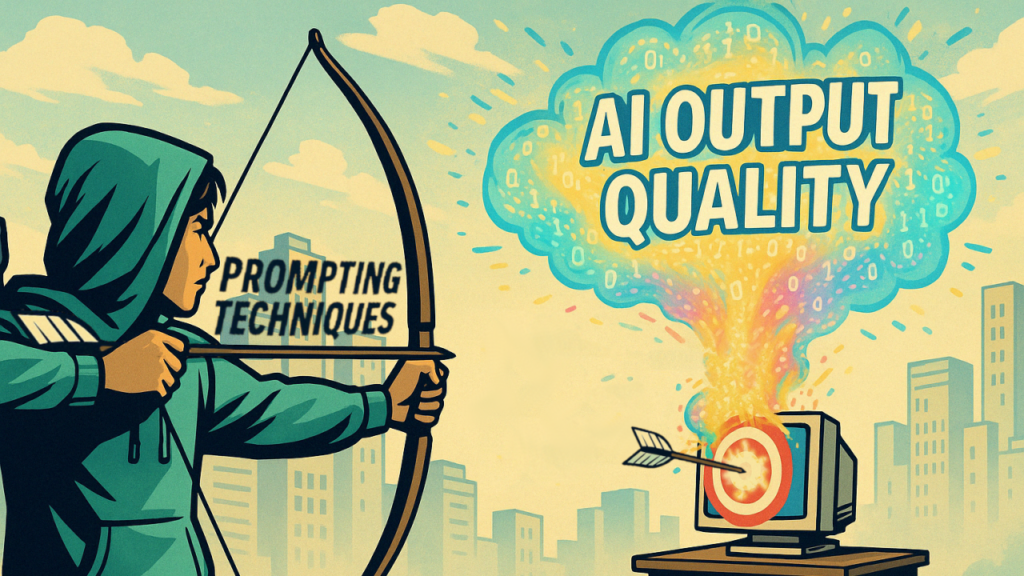
Most people use AI like a fancy search box—but it can do so much more with the right guidance.
What if you could stop poking around with basic prompts and start training AI like a super-smart intern who actually gets your business?
Discover how to unlock truly powerful results with smarter prompting techniques—or skip the read and book a chat with Michael Weinberger to discuss how these methods can be tailored to your business.

The buzz around Artificial Intelligence is undeniable. We see headlines promising revolutionary change, efficiency gains, and creative breakthroughs. Tools like ChatGPT, Claude, and others have become commonplace. Yet, in conversations with business leaders across various sectors, a common theme emerges: initial excitement often gives way to a sense of limitation. “It’s useful for basic things,” they might say, “but it struggles with complex tasks,” or “I can’t seem to get it to understand exactly what I need.”
This reflects a critical gap – not in the AI’s potential, but in our methods of interacting with it. Simply asking a question and hoping for the best rarely unlocks the deeper capabilities these sophisticated models possess. At Proactive Technology Management, our Fusion Development team spends countless hours exploring the nuances of AI interaction, pushing the boundaries of what’s possible, and, crucially, training others to do the same.
Recently, our Director of Fusion Development & AI Systems Architect, Michael Schreiber, conducted a series of training sessions with a client – a driven leader of a non-profit organization focused on community well-being. The goal? To move beyond basic AI usage and build custom AI assistants capable of tackling substantial business needs, specifically grant writing and social media strategy. The insights gleaned from these sessions are too valuable not to share, as they encapsulate the difference between dabbling in AI and strategically implementing it for tangible results.
Michael Schreiber often emphasizes that interacting with today’s advanced AI, especially models designed for deep research or complex thought processes, requires a shift in mindset. Instead of treating the AI like a simple search engine, think of it more like onboardingWhen you join us as a new client, we take all the necessary ... a highly intelligent, incredibly fast, but initially context-less intern. You wouldn’t just hand an intern a stack of reports and say, “Write a grant proposal.” You’d provide context, explain the purpose, detail the desired outcome, and clarify how to use the provided resources.
This analogy underpins several powerful techniques:
One of the most potent techniques Michael champions is Meta Prompting. This involves asking the AI to write a prompt for itself before executing the main task. Why? Because the AI often understands how to structure instructions for optimal results better than we initially do.
The process looks like this:
During the training, Michael guided the client through this process to strengthen her existing grant-writing AI assistant. The initial instructions were okay, but after feeding them to a more advanced model (GPT-4.5) and asking it to strengthen the prompt based on the desired role (expert grant writer), the resulting instructions were significantly more robust, structured, and detailed. This refined prompt was then pasted back into the custom AI’s configuration, instantly leveling up its capabilities.
A related technique is Reverse Meta Prompting. If the AI produces an output you particularly like, you can ask it: “Pull guidelines from how you generated that response that I can use in a custom GPT’s instructions to consistently produce output like this”.
This allows you to capture the “magic” of a good response and make it repeatable.
The process of using a stronger AI model (like GPT-4.5) to generate enhanced instructions for a slightly less advanced, but still powerful, custom AI (often based on GPT-4o) is known as Distillation. You’re essentially borrowing the “brainpower” of the more advanced model to distill highly effective instructions, making the custom AI perform closer to the level of its more powerful counterpart.
Crucially, building effective AI assistants isn’t a one-shot deal. It’s an iterative, almost cybernetic process. You create a prompt, test the output, refine the prompt (perhaps using meta prompting or reverse meta prompting), test again, and repeat.
Importantly, each cycle of iteration improves the AI’s alignment with your specific needs, allowing the model to learn from your preferences.
The difference between users getting basic results and those achieving powerful outcomes often lies in embracing this iterative refinement.
These techniques aren’t just theoretical. During the session, the client applied them to real-world challenges:

The journey from basic AI user to strategic implementer isn’t about becoming a coder; it’s about becoming a better communicator and trainer. By employing techniques like meta prompting, contextualization, and iterative refinement, professionals can guide AI tools to perform complex, nuanced tasks effectively. It requires patience, precision, and a willingness to engage collaboratively with the technology.
The results, as our client experienced, are transformative – moving from generic outputs to tailored solutions that directly address core business challenges like securing funding and building brand presence. This is the true promise of AI in the workplace: not just automation, but augmentation – empowering human expertise with intelligent tools shaped for specific needs.
Are you ready to move beyond basic prompts and unlock the strategic potential of AI for yourself or your team? Proactive Technology Management offers tailored AI training workshops designed specifically for leaders and working professionals. Learn practical techniques to build custom AI assistants, analyze data, streamline workflows, and drive real results.
Schedule a meeting with me, Michael Weinberger, today to discuss how our AI training can empower your organization. Let’s explore how you can harness the full power of AI.